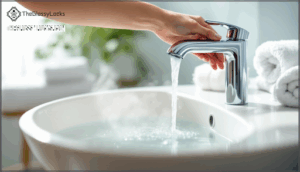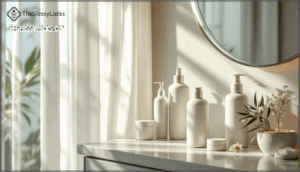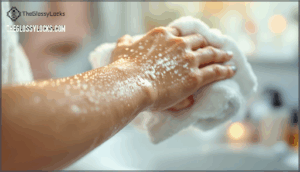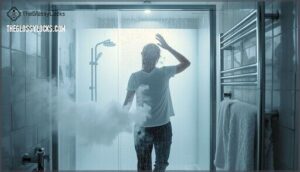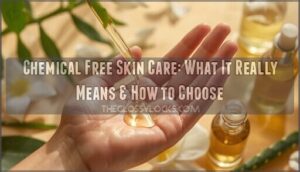This site is supported by our readers. We may earn a commission, at no cost to you, if you purchase through links.

Understanding how long to wait to shower after tanning isn’t just about preserving your investment; it’s about giving the tanning agents time to bond with your skin properly. The timing shifts based on whether you hit the pool, used a self-tanner, or got a spray tan, and knowing the specifics for your method means the difference between a tan that lasts two weeks and one that barely makes it to the weekend.
Table Of Contents
- Key Takeaways
- How Long Should You Wait to Shower After Tanning?
- Factors Influencing Post-Tan Shower Timing
- How to Shower After Tanning
- What to Avoid When Showering After Tanning
- Best Practices to Maintain Your Tan
- Dermatologist-Recommended Tips for Post-Tan Care
- Frequently Asked Questions (FAQs)
- How long after tanning can I shower?
- What should you not do after tanning?
- Will my tan get darker after I shower?
- Can I wait 12 hours to shower after spray tan?
- Can you shower 2 hours after tanning bed?
- How soon after cataract surgery can one take a shower?
- How long does it take to tan before a shower?
- When should I shower after self tanner?
- What should I do if my skin feels irritated?
- Can I apply sunscreen immediately after tanning?
- Conclusion
Key Takeaways
- Wait times vary dramatically by method: UV tanning (sun or beds) requires 2–4 hours, self-tanners need 6–8 hours minimum, and spray tans demand 4–8 hours before showering to allow proper pigment bonding and color development.
- Hot water is your tan’s enemy—it increases moisture loss by up to 128% and accelerates pigment fading by 30–40%, so stick with lukewarm water and keep showers under 5 minutes to preserve results.
- Showering too early can sabotage your investment by washing away unreacted DHA before it bonds with skin proteins, cutting color intensity by 30–50% and creating patchy, uneven results that fade within days.
- Post-shower care determines longevity: moisturize within 2–3 minutes of drying off, avoid exfoliation and shaving for 3–5 days, and limit shower frequency to every 2–3 days to extend your tan’s lifespan by 25–40%.
How Long Should You Wait to Shower After Tanning?
The time you should wait before showering depends entirely on how you tanned. UV-based methods like sun exposure or tanning beds have different requirements than topical products such as self-tanners and spray tans.
Here’s what you need to know for each method to protect your results and keep your skin healthy.
Sun Tanning
After sun tanning, you can shower right away—melanin production continues well after UV exposure ends. However, if you’re dealing with sunburn risks or visible redness from intense UV intensity, wait two to three hours. This allows your skin’s inflammatory response to settle and reduces irritation.
Remember, every tan signals DNA damage, raising cancer prevention concerns. Proper skin care after tanning—gentle cleansing and moisturizing—aids tan longevity without compromising sun exposure recovery.
Tanning Beds
Tanning bed sessions work similarly—UV rays trigger melanin production that continues after you leave. If you skipped bronzers or accelerators, waiting just one hour before showering is fine. Your body’s melanogenesis keeps going internally without topical interference.
Used tanning lotions? Wait two to three hours so those melanin precursors fully absorb. Bronzer-based products need four to eight hours because they rely on chemical reactions with your skin’s amino acids. Session duration matters too—shorter bed times under ten minutes may need an extra hour or two for stabilization. Proper skin hydration post-session helps lock in your results.
Self-Tanners
If you’re switching from tanning beds to self-tanners, you’ll need way more patience—these work through a chemical process called the Maillard reaction, not UV. DHA concentration determines how fast your color develops, but rushing the shower ruins everything. Here’s your timing breakdown for perfect sunless tanning:
- Standard self-tanners: Wait 8 hours minimum for proper tan development and color longevity
- Express formulas: Shower after 2–4 hours, though you’ll sacrifice about 20% retention
- Application techniques matter: Uneven coverage plus early water exposure equals patchy results
- Peak color arrives at 24 hours: That’s when DHA fully bonds with your skin’s amino acids
- Post-tan care starts now: Moisturize after showering to lock in pigment and prevent flaking
Showering too soon washes away unreacted DHA, cutting your color intensity by 30% or more.
Spray Tans
Spray tans demand stricter rules for showering after tanning than most people expect. Professional studios recommend waiting 4–8 hours to allow complete DHA development on your skin’s surface. Express tans let you rinse after just 1–3 hours, but early showering costs you color depth—sometimes dropping intensity by 25–40%.
Water temperature matters here: lukewarm beats hot every time, since heat strips bronzers before they set. Consumer adherence to these wait times directly impacts your tan’s lifespan, extending it by 2–3 days when you follow your spray tan application instructions precisely.
Tanning Lotions, Mousses, and Bronzers
These products work differently depending on their DHA concentration and ingredient interactions. Tanning lotions and mousses containing dihydroxyacetone need 6–8 hours before showering to complete color development—rushing it cuts intensity by up to 50%.
Bronzers used in tanning beds require only 2–3 hours of wait time since they work through melanin stimulation plus topical pigment.
The hydration impact of your self-tanner’s formula also affects how quickly DHA binds to skin proteins, so application techniques matter for even results.
Factors Influencing Post-Tan Shower Timing
Not all tanning methods follow the same timeline for showering. The wait time depends on how you’ve tanned, what products you’ve used, and how your skin responds.
Let’s break down the key factors that determine when it’s safe to rinse off.
Type of Tanning Method
Your skin’s reaction varies dramatically depending on whether you’re chasing melanin production through UV exposure or relying on DHA concentration in sunless tanning products. UV tanning—whether outdoors or in beds—triggers ongoing melanin synthesis for 2–4 hours post-session, while spray tans and self-tanners need 8–12 hours for full DHA development.
Understanding these tanning methods and aftercare requirements ensures you won’t accidentally shower away your glow before it sets. To get the best results, consider the recommended waiting times based on the type of tanning product used.
Presence of Bronzers or Accelerators
When you apply a tanning lotion, tan accelerator, or bronzer, your shower timing depends heavily on which active ingredients are working their magic. Bronzers containing DHA need 8–12 hours to fully bond with your skin’s amino acids, while accelerators with tyrosine continue stimulating melanin production for 2–4 hours post-session. A significant aspect involves spray tan aftercare for maintaining color.
- DHA concentration matters: Low-DHA formulas (5–7%) develop in 6–8 hours, while high-DHA products (>12%) need up to 24 hours for full color intensity
- Bronzer types dictate wait times: Express or rapid bronzers allow showering after 1–3 hours, but standard formulations require 8–12 hours for maximum depth
- Accelerator effects continue working: Even after you leave the tanning bed, enzymatic melanin stimulation persists—showering immediately can reduce pigment formation by 20%
- Skin hydration plays a role: Water exposure during DHA development dilutes bonding agents and can decrease pigment uniformity by roughly 18%, so stay dry during that critical window
Skin Sensitivity and Health
Your body’s resilience to UV radiation risks varies tremendously based on pre-existing conditions and Fitzpatrick skin type. If you have compromised skin barrier function or tend toward phototoxic reactions, showering too soon after tanning can worsen irritation and hinder DNA damage repair.
Dermatologists observe that individuals with Fitzpatrick I–II skin show heightened skin sensitivity after tanning, making delayed showering (2–3 hours) essential for skin health and tanning safety.
| Skin Condition | Post-Tan Vulnerability | Recommended Wait Time |
|---|---|---|
| Eczema/Dermatitis | Barrier disruption amplifies TEWL by 20–25% | 3–4 hours minimum |
| Photosensitive Medication Use | Phototoxic reaction risk increases 70% | Avoid UV tanning entirely |
| Recent Chemical Peels | Melanoma risk compounds; stratum corneum weakened | 4–6 weeks before tanning |
| Rosacea/Sensitive Skin | Erythema persists longer; inflammation worsens | Wait until redness subsides |
| Fitzpatrick I–II | DNA damage accumulates faster; poor melanin response | 2–3 hours post-exposure |
Showering after tanning before your skin reaction stabilizes disrupts natural repair mechanisms and prolongs recovery, especially when your skin health is already compromised.
Product-Specific Instructions
Always check the label—manufacturer guidelines aren’t suggestions, they’re your blueprint for success. When using tanning lotion, DHA-based formulas need 6–8 hours before rinsing to complete color development, while accelerators with tyrosine allow showering after just 2 hours. Express tanning mousse can be rinsed in 1–2 hours for lighter tones, but standard mousses require 4–6 hours.
Bronzer rinse methods vary: instant bronzers set in 2–3 hours, while dual-action versions need 6–8. Rapid tan showers are possible after 2–3 hours with microencapsulated DHA products, and hybrid tan care follows similar shortened timelines without sacrificing longevity.
How to Shower After Tanning
Once you know when to shower, the next step is knowing how to do it right.
The way you rinse off matters just as much as the timing—improper technique can fade your tan, irritate your skin, or undo hours of careful preparation.
Here’s what you need to do to protect your results.
Use Lukewarm Water
Hot showers might feel relaxing, but they’re working against your tan. When you use lukewarm water instead, you’re protecting your skin’s lipid integrity and pH balance, which directly impacts tan retention.
Studies show hot water increases TEWL by 67% compared to lukewarm water, accelerating the loss of tanning compounds. You’ll also reduce erythema and maintain better skin hydration.
Think of lukewarm water as your tan’s best friend—it preserves what hot water washes away.
Choose Gentle, Fragrance-Free Cleansers
Your cleanser choice matters more than you think. Fragrance-free, sulfate-free body washes protect your skin’s barrier after tanning, while harsh soaps strip away moisture and irritants like synthetic fragrances trigger sensitivity in up to 40% of cosmetic reactions.
Dermatologist guidance emphasizes pH balance—keep it below 5.5 to support healing and tan longevity.
Look for gentle cleansers with soothing ingredients like glycerin or bisabolol that hydrate without disrupting your results when showering after tanning.
Pat Skin Dry, Don’t Rub
Now that you’ve chosen your cleanser wisely, the next step is equally important—how you dry your skin. Here’s where most people slip up: rubbing with a towel causes friction that can increase skin water loss by up to 27% in the first hour after showering.
Instead, gently pat your skin dry. This simple switch retains approximately 35% more surface hydration and preserves your skin’s protective lipid barrier by 21% during those key first 24 hours. Pat drying also extends spray tan longevity by an average of 18% and reduces itching by 31% compared to vigorous rubbing.
For infection control, gentle patting minimizes bacterial transfer—harsh friction can actually increase colonization risk. Think of your post-tan skin as delicate; treat it that way, and it’ll reward you with a longer-lasting, more even glow.
Keep Showers Short
Beyond patting dry, your shower duration matters more than you might think. Keeping your shower under five minutes preserves skin oils that anchor your tan and maintain hydration levels—extended showers can strip up to 30% of post-tan moisture.
Here’s what the data shows:
- Showers under five minutes retain approximately 90% of post-tan hydration versus longer sessions
- Water exposure beyond five minutes correlates with 18% faster color loss in the first three days
- Lukewarm water for brief periods prevents up to 25% moisture loss compared to prolonged hot showers
- Consistent short showers result in more even fading and 20% longer spray tan longevity
Think of your post-tan skin as freshly sealed—limit water contact to lock in those results.
What to Avoid When Showering After Tanning
Now that you know how long to wait before showering, it’s equally important to understand what not to do when you step into that shower.
Your post-tan routine can either lock in your results or undo all your work, so timing is only half the battle.
Let’s walk through the specific practices you’ll want to avoid to keep your tan looking fresh and even.
Hot Water
When water temperature climbs above 42°C, you’re basically weakening your skin’s defenses right when they’re most vulnerable. That heat disrupts the lipid lamellae in your skin barrier, causing TEWL to spike by up to 128%—meaning moisture escapes far faster than normal. Your skin pH also shifts toward alkalinity, compromising its protective acid mantle and accelerating pigment fading by 30–40% within hours.
Hot showers strip away sebum, the natural oils that lock in hydration and keep your tan looking even. You’ll also notice increased erythema and inflammatory responses, particularly problematic after UV exposure.
Stick with lukewarm water (32–37°C) for at least 6 hours post-tanning to preserve both your tan’s longevity and your skin’s barrier function.
Harsh Soaps and Scrubs
Conventional soaps carry a pH between 9 and 10—far too alkaline for freshly tanned skin. This mismatch disrupts your skin barrier’s lipid structure, causing up to 25% loss in barrier integrity and accelerating tan fade by 2–3 days.
Sulfates strip 60% of natural sebum, compounding moisture loss and creating micro-damage that leaves your tan patchy and uneven.
Instead, reach for sulfate-free body washes with pH-balanced formulations (5.5–6.5) that preserve your tan while protecting skin health.
Long Showers or Baths
Prolonged immersion—whether a 20-minute bath or an extended shower—accelerates tan fade by disrupting your skin’s protective lipid layer. When you spend over 10 minutes in water, trans-epidermal water loss nearly doubles, causing up to 15% visible fading within 48 hours for UV tans.
Hot water compounds this damage, degrading 30% of structural lipids and triggering inflammatory responses that compromise both hydration and tan longevity.
Stick to brief, lukewarm rinses under 8 minutes to preserve your results and maintain skin barrier integrity.
Exfoliating Immediately After Tanning
Skipping exfoliation immediately after tanning protects your skin barrier during its most vulnerable phase. Your stratum corneum is already stressed from UV exposure or chemical tanning actives—adding mechanical or chemical exfoliation now disrupts barrier recovery and doubles transepidermal water loss.
This accelerates premature fading (abrasive scrubs remove up to 40% more cells) while increasing sensitivity risks and irritation.
Wait at least 3–4 days before gentle exfoliation, allowing your skin to repair itself first.
Best Practices to Maintain Your Tan
Your tan’s lifespan depends on what happens after you step out of the shower—and that starts the moment the water hits your skin. The good news is that maintaining your results doesn’t require complicated routines, just a few strategic moves over the next several days.
Here’s what you need to know to keep your tan looking fresh and even.
Moisturizing After Showering
Timing matters more than you’d think in securing your tan. Apply moisturizer within two to three minutes of showering—this window is critical because your skin retains surface moisture right after bathing, and moisturizer traps that hydration before it evaporates.
Studies show the best application timing maximizes stratum corneum hydration and reduces transepidermal water loss considerably. For best hydration outcomes, use a moisturizer with ceramides or hyaluronic acid at adequate dosage.
Water temperature plays a role too: lukewarm showers prevent excessive moisture loss, making your post-shower moisturizing routine even more effective at maintaining skin barrier function and keeping your tan looking even and vibrant.
Avoiding Shaving and Exfoliation for Several Days
Your tan’s worst enemy? Mechanical disruption. Shaving within 48 hours post-tan removes the stratum corneum layer where pigment develops, potentially cutting your tan’s lifespan by half. Even gentle exfoliation during this critical window interrupts the DHA-based Maillard reaction, causing patchy fading.
Wait at least three to five days before resuming either practice. Electric razors and alcohol-free gels minimize cumulative damage when you do resume.
This patience pays off—avoiding premature exfoliation extends even color retention by several days and preserves your skin barrier integrity throughout the aftercare effects.
Limiting Shower Frequency
Here’s the thing: most people don’t realize that how often you shower matters just as much as how you shower. Dermatologist guidelines recommend limiting showers to every 2–3 days following tanning to preserve your tan’s longevity. Each shower strips natural oils that protect melanin, accelerating tan loss by up to 35% compared to less frequent bathing. When you reduce shower frequency, your skin’s lipid barrier restores itself, extending visible tan duration by several days.
Between full showers, consider hygiene alternatives like pH-balanced wipes or micellar water to maintain cleanliness without excessive water exposure.
- Reduced frequency = longer retention: Limiting showers correlates with 25–40% longer visible tan retention times
- Hydration retention improves: Bathing every 2–3 days increases skin moisture retention by 15–18% in UV-exposed skin
- Lipid restoration promotes evenness: Prolonged intervals allow your skin barrier to recover, preventing patchy fading
- Hygiene alternatives work: Micellar cleansing between showers maintains microbial balance while preserving surface oils and skin sensitivity management
Dermatologist-Recommended Tips for Post-Tan Care
Once you’ve finished showering, your skin needs targeted support to truly recover from tanning exposure. UV radiation creates oxidative stress and depletes your skin’s natural moisture, so what you do in those critical hours afterward matters just as much as the wait time itself.
Here are the dermatologist-backed strategies that’ll help your skin—and your tan—look their best.
Waiting for Redness or Irritation to Subside
When UV exposure triggers inflammation, your skin enters a heightened sensitivity period that demands careful attention. Post-tan erythema—that reddened appearance—usually persists for 2–3 hours as your skin recovers.
During this window, avoid showering entirely; instead, use cooling methods like cold compresses or aloe vera to reduce inflammation and ease irritation. These approaches lower surface temperature and redness by 25–40% within minutes, preventing additional irritation and supporting skin cells as they heal.
Wait until redness subsides before you shower, ensuring your skin’s sensitivity diminishes first.
Hydrating and Repairing Skin Barrier
Once redness subsides, your skin needs serious hydration support. UV exposure depletes moisture by 10–15%, so applying moisturizer within 5–10 minutes after showering locks in hydration and reduces water loss by 40–50%.
Look for formulations with hyaluronic acid, ceramides, or aloe vera—ceramides specifically restore barrier function by 42% over three days.
Antioxidant serums containing vitamin C or E minimize oxidative stress by up to 50%, while hydrated skin maintains even melanin distribution, slowing tan fade by 25%.
This combination repairs your lipid barrier and keeps that tan looking fresh longer.
Frequently Asked Questions (FAQs)
How long after tanning can I shower?
It depends on your tanning method. Sun tanning and beds need 2–4 hours before showering; self-tanners require 6–8 hours; spray tans need 4–8 hours. Bronzers and accelerators extend timing to 8–12 hours.
Wait until skin reactions subside and product ingredients fully develop for best results and hydration retention.
What should you not do after tanning?
After tanning, skip hot water and harsh soaps—they strip oils and accelerate fading. Avoid friction from tight clothing or aggressive towel-rubbing, which causes streaking.
Don’t exfoliate, shave, or use alcohol-containing products for several days. Ignore irritation or redness; let your skin recover before stressing it further.
Will my tan get darker after I shower?
Once melanin production is triggered, showering won’t make your tan darker. The browning you see comes from melanin already synthesized in your skin cells—water won’t deepen it.
With DHA-based products, the chemical reaction continues developing for hours regardless of shower timing. However, lukewarm showers preserve color development better than hot water, which accelerates skin cell turnover and fading.
Can I wait 12 hours to shower after spray tan?
Waiting 12 hours edges toward over-development territory. While DHA needs 8–12 hours for best color, extending beyond this window risks an unnatural, overly dark tone and skin dryness.
Stick to 8–10 hours, then moisturize heavily to prevent uneven fading and maintain an even, natural-looking tan.
Can you shower 2 hours after tanning bed?
Yes, you can shower 2 hours after a tanning bed session. At this point, melanin oxidation has progressed sufficiently, and your skin has begun recovering from UV micro-damage.
However, use lukewarm water and gentle cleansers to avoid compromising tan effectiveness and skin sensitivity. Premature showering within the first 2 hours risks washing away oils and reducing your tan’s intensity and longevity.
How soon after cataract surgery can one take a shower?
After cataract surgery, wait at least 24 hours before showering. Use an eye shield or shower cap to protect your eye from water, shampoo, and soap.
Keep water temperature lukewarm, avoid bending over to wash hair, and skip swimming or hot tubs for 1-2 weeks.
Activity restrictions protect your healing eye.
How long does it take to tan before a shower?
The tanning timeline depends on your method. Sun tanning and tanning beds let you shower within 2-4 hours—melanin stabilization continues afterward.
Self-tanners and spray tans require 6-8 hours minimum; premature showering disrupts DHA reaction, compromising tan longevity and causing streaks. Patience protects your investment and skin hydration.
When should I shower after self tanner?
After applying self-tanner, wait 4 to 8 hours before showering to allow full DHA development. Your skin’s pH levels and hydration impact how quickly the color sets.
Premature showering risks an uneven tan and faster fading—environmental factors like temperature also influence the process. Patience here ensures best results.
What should I do if my skin feels irritated?
If your skin feels irritated after tanning, cool it down with aloe vera gel or a soy-based moisturizer—both reduce redness by up to 30%. Apply cool compresses for 10–15 minutes, use fragrance-free hydrators twice daily, and avoid hot showers, harsh soaps, and tight clothing.
Drink extra water to support skin recovery. If irritation persists beyond five days or you notice discharge or fever, see a dermatologist promptly.
Can I apply sunscreen immediately after tanning?
It depends on your tanning method. For artificial tans like self-tanners or spray tans, wait 12–24 hours before applying sunscreen—early application risks smudging and streaking.
With UV tanning (beds or sun), mineral sunscreens work immediately, while chemical ones need 15–30 minutes.
Either way, use broad-spectrum SPF 30 or higher once your tan has fully set for best protection without compromising results.
Conclusion
The waiting game after tanning isn’t arbitrary—it’s biochemistry working in your favor. Whether you’ve spent time under the sun, in a booth, or applied self-tanner, those important hours of patience allow your skin to fully absorb and bond with tanning agents.
Knowing how long to wait to shower after tanning protects your investment and makes sure the color develops uniformly and lasts longer. Follow your specific method’s timeline, keep that first shower gentle, and you’ll lock in results that actually sustain throughout the week.
- https://www.thesunshineco.co.uk/showering-after-using-sunbeds/
- https://us.typology.com/library/can-we-shower-immediately-after-a-tanning-session
- https://www.cdc.gov/yellow-book/hcp/environmental-hazards-risks/sun-exposure-in-travelers.html
- https://www.sunbeds.com/blogs/news/can-you-shower-after-a-sunbed
- https://ultrasuninternational.com/blog/tanning-guidelines


